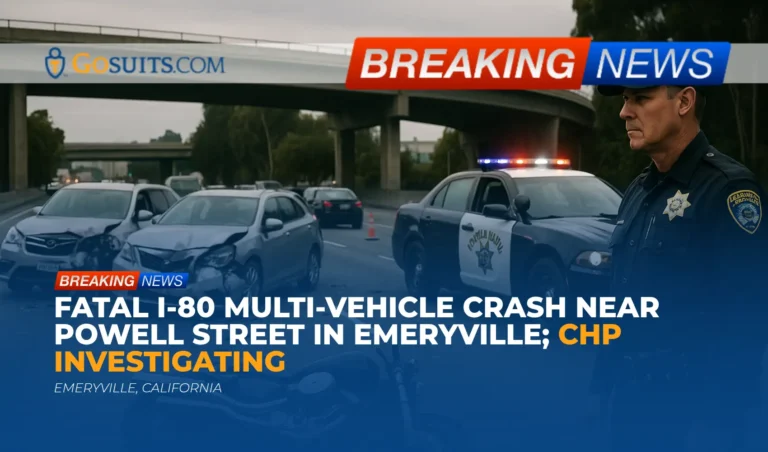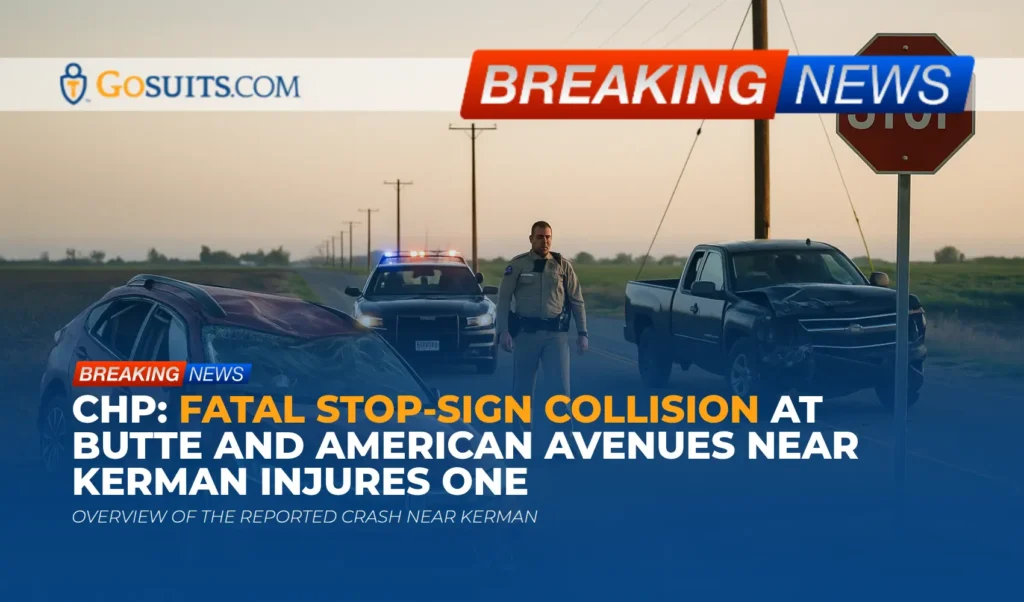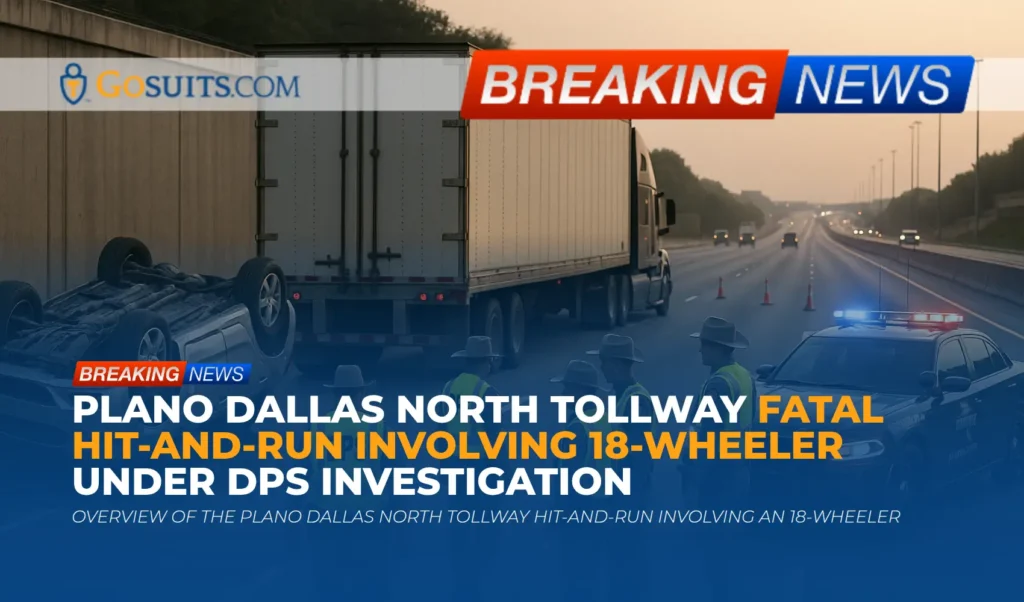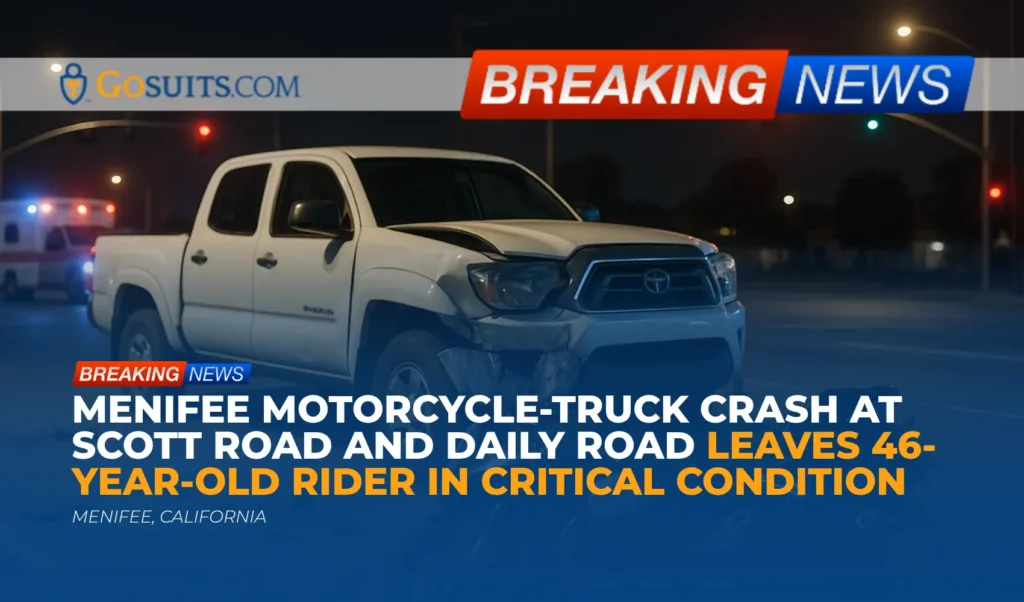- What We Know About the I-80 Multi-Vehicle Crash in Emeryville
- Location and Roadway Context on Eastbound I-80 near Powell Street
- Ongoing Investigation and How Multi-Vehicle Crashes Are Analyzed
- Potential Civil Liability Pathways After a Freeway Fatality
- Insurance Layers That May Apply in a Four-Vehicle Collision
- Records and Information Families Can Request
- Preserving Evidence and Documenting Losses
- California Wrongful Death and Survival Claims Overview
- Timelines and Deadlines That Commonly Apply
- Community Safety Context and Motorcycle Risk Data
- Common Insurance Tactics and How to Respond Safely
- Why Acting Promptly Matters After a Multi-Vehicle Freeway Crash
- Commentary from Gosuits Emeryville, California Personal Injury Attorney
What We Know About the I-80 Multi-Vehicle Crash in Emeryville
Authorities report a deadly collision on eastbound Interstate 80, just west of Powell Street in Emeryville, on Sunday afternoon at approximately 2:30 p.m. According to the California Highway Patrol, four vehicles were involved, including a motorcycle. The motorcyclist died as a result of the crash. Officials have indicated that the cause of the collision remains under investigation, and no further details have been publicly confirmed at this time.
In the immediate aftermath of an incident like this, the responding agency typically documents the scene, gathers statements from involved drivers and witnesses, and preserves physical evidence from the roadway. For crashes on California freeways, the California Highway Patrol usually leads the investigation and prepares the primary collision report.
Location and Roadway Context on Eastbound I-80 near Powell Street
Interstate 80 is one of the busiest corridors in the Bay Area. The stretch near Powell Street has multiple lanes, merges, and frequent congestion, all of which can elevate the risk of chain-reaction events. Multi-vehicle collisions on a high-speed limited-access highway often involve complex dynamics, including sudden braking, lane changes, following distances, and visibility factors.
While the precise circumstances of this crash are still being reviewed by authorities, freeway environments commonly present overlapping hazards, such as heavy traffic volumes, rapidly changing speeds, and limited stopping distances. These operational realities often play a role in multi-vehicle impacts and the severity of injuries to unprotected road users like motorcyclists.
Ongoing Investigation and How Multi-Vehicle Crashes Are Analyzed
When multiple vehicles collide, investigators typically consider a wide range of evidence to determine the sequence of events and whether any driver failed to use reasonable care. Some common steps include:
- Scene documentation including measurements, photographs, skid mark analysis, final rest positions of vehicles, and roadway conditions.
- Vehicle inspections for crash damage patterns, lighting status, and mechanical issues that may have contributed to the collision.
- Witness statements to capture perspectives on traffic flow, speed, lane changes, sudden stops, and any erratic behavior observed.
- Electronic data such as Event Data Recorder information from passenger vehicles and potential GPS or telematics data.
- Environmental factors including weather, sun glare, surface conditions, construction zones, or debris.
In a four-vehicle event, fault can be shared across multiple drivers, or it may rest primarily with one. California’s comparative fault system allows responsibility to be apportioned among different parties based on their respective contribution to the crash, which can impact claims for wrongful death and survivor benefits.
Potential Civil Liability Pathways After a Freeway Fatality
Although the official cause here has not been released, families affected by a fatal freeway crash commonly consider civil claims grounded in negligence. In general terms, a driver may be liable if they failed to act with reasonable care under the circumstances and that failure caused harm. In multi-vehicle collisions, potential sources of civil liability can include:
- Following too closely or unsafe speed in congested conditions leading to rear-end impacts or insufficient stopping distance.
- Unsafe lane changes without adequate signaling or clearance, potentially causing sideswipe or cut-off scenarios.
- Distracted driving that delays reaction time or reduces situational awareness.
- Impaired driving by alcohol or drugs, subject to proof through the investigation.
- Vehicle defects or maintenance failures if a mechanical issue contributed to the loss event.
Depending on facts confirmed by the CHP investigation, liability may also involve commercial carriers or employers if a driver was operating in the course of employment, or public entities if unique roadway defects or hazards played a role. These are fact-specific determinations that usually require careful review of the collision report, supporting records, and physical evidence.
Insurance Layers That May Apply in a Four-Vehicle Collision
Insurance is often multilayered in a multi-vehicle crash, and recovering through the available coverages can be complex. Relevant policies may include:
- At-fault driver’s liability coverage. California law requires minimum financial responsibility limits for private passenger vehicles. The Department of Motor Vehicles explains the minimum liability limits required for drivers in the state, which can be low relative to the costs associated with a fatal loss. See DMV guidance on financial responsibility requirements at the California DMV site: dmv.ca.gov.
- Uninsured and underinsured motorist coverage on the motorcycle or household policies. The California Department of Insurance provides consumer guidance regarding UM and UIM coverage, which can respond when the at-fault party has no insurance or insufficient limits. See the Department of Insurance resource on uninsured motorist coverage: insurance.ca.gov.
- Medical payments benefits if present on the motorcycle policy. These first-party benefits vary by policy and carrier.
- Umbrella or excess policies that may add coverage limits above standard auto policies for individuals or companies.
- Employer or commercial policies when a driver was acting within the scope of employment at the time of the crash.
Determining which policies apply often requires reviewing declarations pages, confirming policy language, and coordinating with multiple insurers. Because statements to insurers can be used to challenge a claim later, it is generally wise to seek a free consultation with a qualified attorney before giving recorded statements or signing any forms.
Records and Information Families Can Request
Following a freeway fatality, several public records can help clarify what happened and assist with insurance and civil claims. The following agencies typically hold critical documents. Contact information and request steps are provided via official government resources.
California Highway Patrol Collision Report
For freeway crashes in Emeryville, the California Highway Patrol is the primary reporting agency. Families can generally request a copy of the collision report using the CHP process and form. The CHP describes how to request a collision report here: chp.ca.gov. Requesters may need to verify their relationship to the involved parties and include the date, time, and location of the incident, along with the report or incident number if known.
The collision report often includes diagramming, narratives, any citations or noted violations, witness statements, and sometimes preliminary fault assessments. Supplemental reports may be generated if the investigation continues over multiple days.
Alameda County Coroner and Autopsy Records
When a death occurs, the county coroner or medical examiner typically investigates and may conduct an autopsy. In Alameda County, the Coroner’s Bureau is part of the Sheriff’s Office. Information about the Coroner’s Bureau and how to request records can be found through Alameda County’s official site: acgov.org. Autopsy and coroner reports can be highly sensitive, and release is governed by California law. Next-of-kin typically have certain rights to request these records.

Death Certificates and Vital Records
Certified copies of death certificates are often required for insurance and estate matters. In Alameda County, the Clerk-Recorder’s Office manages vital records. Details on obtaining death certificates are available via the county’s official site: acgov.org. Requirements usually include proof of identity and relationship, and fees may apply.
Preserving Evidence and Documenting Losses
In the weeks after a multi-vehicle crash, timely evidence preservation can be critical. Important steps often include:
- Preserve vehicles in their post-crash condition until they can be inspected and photographed. Avoid authorizing repairs or salvage before documentation.
- Secure phone and camera footage from witnesses and dash cameras. Collect contact information for anyone who recorded the scene.
- Request nearby camera footage from roadway agencies or businesses in the area, recognizing that many systems overwrite data quickly.
- Keep all medical and funeral documentation, including invoices, memorial expenses, and benefits statements.
- Track out-of-pocket costs that arise directly from the loss, such as travel for arrangements or estate administration expenses.
Because insurance companies can dispute the cause or the extent of loss, meticulous documentation can make a meaningful difference in establishing the facts and the full scope of damages.
California Wrongful Death and Survival Claims Overview
California law provides pathways for certain family members to bring civil claims after a fatal incident. These claims are complex and must be evaluated against the specific facts of the crash. Key concepts include:
- Wrongful death claims allow specified survivors to seek compensation for losses they suffer because of a loved one’s death, such as loss of financial support and companionship. Eligibility for who may bring a wrongful death claim is described in California Code of Civil Procedure section 377.60, available at the state’s official legislative website: leginfo.legislature.ca.gov.
- Survival actions allow the decedent’s estate to pursue claims the decedent could have brought had they survived, such as certain economic damages incurred between injury and death. See California Code of Civil Procedure section 377.30: leginfo.legislature.ca.gov.
- Comparative fault can reduce recoveries proportionally if multiple parties share responsibility. Liability and damages typically hinge on the CHP report, witness accounts, physical evidence, and expert analysis.
These claims are civil in nature and are distinct from any criminal enforcement actions that authorities may consider. The availability and measure of damages depend on the circumstances of the crash and the relationships recognized under California law.
Timelines and Deadlines That Commonly Apply
California has specific time limits to bring civil actions. Missing a deadline can forfeit the ability to recover. Important statutory timelines include:
- General statute of limitations for wrongful death is typically two years from the date of death under California Code of Civil Procedure section 335.1. See the statute text at: leginfo.legislature.ca.gov.
- Government claims when a public entity may be implicated often must be presented within six months under the Government Claims Act. See California Government Code section 911.2 at: leginfo.legislature.ca.gov.
Because determining whether a public entity is involved can require analysis, many families choose to evaluate potential deadlines early. If multiple vehicles and possible commercial or governmental actors are involved, multiple notice requirements may apply.
Community Safety Context and Motorcycle Risk Data
Fatal motorcycle crashes resonate across communities because riders are among the most vulnerable travelers on our roads. Nationally, motorcyclist fatalities have grown in recent years. NHTSA’s motorcycle safety page discusses risk factors and protective measures for motorcyclists, including helmet effectiveness and visibility strategies. See NHTSA’s motorcycle safety materials at: nhtsa.gov.
Some important data points from federal sources:
- Helmet effectiveness. NHTSA notes that helmets are a critical protective factor and can significantly reduce the risk of death and head injury. California law requires compliant helmets for riders and passengers. See California Vehicle Code section 27803 at the state’s legislative site: leginfo.legislature.ca.gov.
- Overall burden. In recent years, thousands of motorcyclists have died annually in the United States. Understanding common crash types, such as multi-vehicle collisions at higher speeds, helps highlight the need for vigilant driving by all road users.
A freeway multi-vehicle crash involving a motorcyclist commonly results in severe trauma because riders lack the protective structure of a passenger vehicle. Even with safety gear, energy transfer in multi-vehicle impacts can be catastrophic. This is why detailed investigations, fair claims handling, and community-wide attention to safe driving practices are so important.
Common Insurance Tactics and How to Respond Safely
After a fatal crash with multiple vehicles and insurers, it is not unusual for insurance companies to move quickly to gather statements and to limit exposure. Common tactics include:
- Early recorded statements seeking admissions or approximations about speed, distances, or the sequence of events that can later be used to dispute liability.
- Low initial settlement offers presented before the full extent of losses is documented, sometimes conditioned on broad releases of claims.
- Disputes over causation based on selective readings of preliminary reports or incomplete evidence.
- Policy coordination hurdles where multiple carriers point to each other, complicating benefits from UM, UIM, or umbrella coverage.
A careful and informed approach can reduce these risks:
- Consult with an attorney before speaking to insurance companies, especially about recorded statements. What is said to an insurer can be used to minimize or deny claims later.
- Collect and preserve documents such as the CHP collision report, coroner records, medical bills, funeral invoices, and any available footage.
- Request policy information in writing to clarify applicable coverage limits and endorsements.

Why Acting Promptly Matters After a Multi-Vehicle Freeway Crash
This section is intended to help readers understand why timely steps are important following a serious multi-vehicle crash, without urging any specific individual to take legal action. Acting promptly can protect rights, preserve evidence, and support informed decisions.
- Exact step to take: Secure official records. Request the CHP collision report, coroner records, and certified death certificates through the relevant government offices. Benefit: Clear documentation provides the factual backbone for insurance claims and estate matters. Urgency: Agencies may take weeks to process, and early requests help keep timelines on track.
- Exact step to take: Preserve physical and digital evidence. Keep vehicles, photographs, dashcam files, and any third-party footage. Benefit: Preserved evidence can clarify fault and combat disputed narratives. Urgency: Towing yards and camera systems may purge data or salvage vehicles quickly.
- Exact step to take: Identify all potentially applicable insurance policies. Review the at-fault driver’s policy, the rider’s own policies, any household policies, and possible umbrella coverage. Benefit: Multiple coverage layers can be coordinated to address major losses. Urgency: Notice duties and claim-reporting deadlines apply, and delayed notice can complicate coverage.
- Exact step to take: Evaluate statutory deadlines. Consider the two-year wrongful death limitations period and whether any government claims deadlines may apply. Benefit: Protects the ability to pursue civil remedies if appropriate. Urgency: Government claims often must be filed within six months, far sooner than the general statute.
- Exact step to take: Obtain a free consultation with a seasoned injury attorney before speaking with insurers. Benefit: Understanding rights and risks helps avoid statements that may be taken out of context. Urgency: Insurers sometimes request recorded statements shortly after a crash.
Where and when action matters most:
- Where: On freeways like I-80, there are often traffic and security cameras, but these recordings may be overwritten on short cycles. Requests to preserve pertinent footage are time-sensitive.
- When: Within days to weeks after the crash, coordinate with the CHP for report numbers and initiate public records requests, while arranging secure storage and inspection of involved vehicles.
- Why: Timely steps tend to reduce disputes about fault, provide clarity to insurers, and ensure that critical deadlines are not missed.
Commentary from Gosuits Emeryville, California Personal Injury Attorney
Our hearts are with the family, friends, and community members affected by this tragic crash on I-80 near Powell Street. This discussion is offered for general information to help the community understand the kinds of issues that often arise after a fatal multi-vehicle collision.
Based on what authorities have shared so far, this was a complex four-vehicle crash in a high-speed corridor. In collisions like this, responsibility can be shared or concentrated with a single driver, and answers usually emerge only after a complete investigation. The CHP collision report, physical evidence, and available camera footage will be central to understanding how the sequence unfolded.
Insurance carriers and large corporations have substantial resources and established procedures designed to protect their own interests. That can leave grieving families at a disadvantage, especially when multiple insurers are involved. We often see early requests for recorded statements, rapid low offers, and attempts to steer the process before complete facts are known. These practices can erode the value of claims if not handled carefully.
A free consultation with a skilled injury attorney can provide clarity about potential coverage layers, the types of damages that may be available under California law, and the timelines that must be met. Speaking with counsel first helps ensure that communications with insurers are accurate, appropriately limited, and fully informed, recognizing that statements can be used later to challenge claims.






